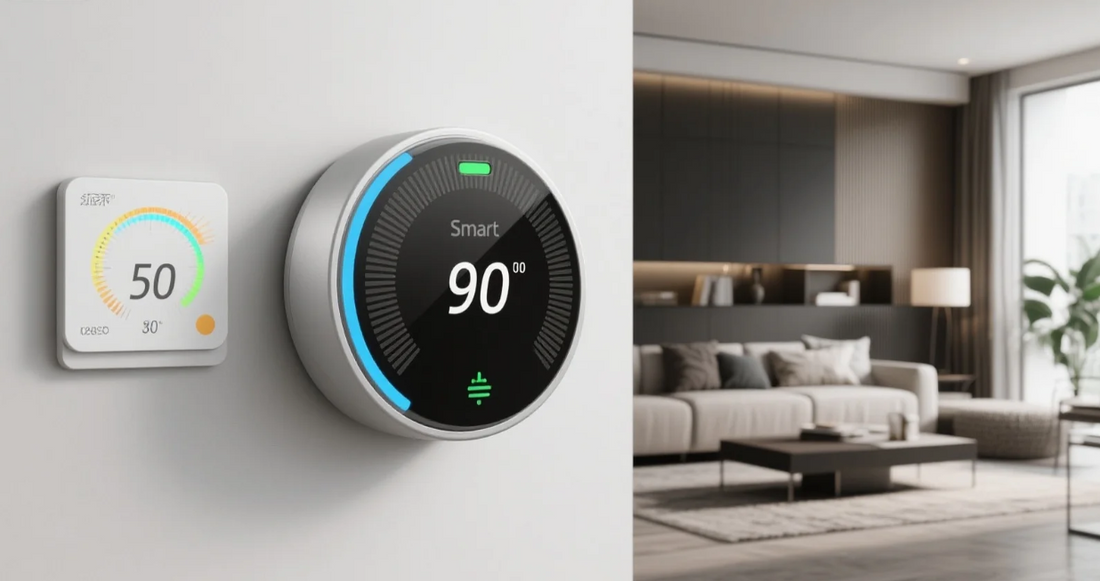
Smart Programmable Thermostat: Control Comfort, Cut HVAC Costs
Share
A smart programmable thermostat brings together the simplicity of scheduled temperature control and the convenience of remote access. In the first 100 words, users are promised practical guidance on how these devices enhance smart-home comfort and reduce heating/cooling costs. Moreover, this article blends technical clarity, smooth transitions, professional depth, and real-world relevance—without overusing the keyword.
Defining a Smart Programmable Thermostat

A smart programmable thermostat is a modern HVAC control unit that allows users to set weekly temperature schedules while also offering Wi-Fi connectivity for remote access and automation. Unlike traditional programmable units that depend solely on manual programming, smart versions include features like occupancy-based auto-scheduling, learning algorithms, and integration with home environments.
Energy Benefits and Savings
Setback Scheduling & Efficiency
According to the U.S. Department of Energy, lowering temperature by 7–10°F for just 8 hours daily can yield up to 10% annual savings on heating and cooling. Yet, traditional programmable thermostats often underdeliver, as programming errors and complexity limit effectiveness.
Smart Learning and Adaptive Control
Smart models overcome these limitations through features like auto-scheduling and occupancy-based adjustments. For instance, Nest’s MyEnergy study showed average savings of ~10% on gas use and ~17.5% on cooling electricity after installing a smart thermostat. Similarly, research from EnergyHub found a 6% reduction in whole-home electricity use for users leveraging web- and mobile-connected smart thermostats.
Remote & Voice Integration
With Wi-Fi connectivity, smart programmable thermostats can be adjusted via smartphones or voice assistants. Many units also offer geofencing and occupancy logging, optimizing comfort and efficiency.
Underlying Technology Explained
These thermostats incorporate sensors—temperature, humidity, motion—and algorithms or machine learning to infer occupancy and routines. Connected via Wi-Fi to cloud platforms, they pull weather data, send energy reports, and accept remote commands.
Installation & Compatibility
Most models require a common (C) wire for power; if absent, a C-wire adapter or professional assistance may be needed. EdgeAnt’s Wi-Fi programmable thermostat, for example, includes a C-wire adapter and supports over 90% of HVAC systems, making installation DIY-friendly (~30 minutes).
Practical Smart-Home Applications
Automatic routines: Temperatures adjust based on schedule or location, enhancing comfort while reducing waste.
Smart integrations: Thermostats can sync with lighting, security, or energy-monitoring systems to optimize home-wide efficiency.
Energy-awareness: Alerts for filter changes or extreme humidity help maintain HVAC performance.
Marketing Focus: EdgeAnt Programmable Thermostat

EdgeAnt markets a smart programmable thermostat that balances practicality with energy efficiency. It features:
7-day programmable schedule with intuitive interface and large backlit display
Wi-Fi connectivity, voice control compatibility (Alexa & Google Assistant), remote app control via Smart Life
Convenience features: temperature alerts, filter reminders, auto time syncing, child lock
This thermostat is positioned as ideal for tech-savvy homeowners seeking simplicity and purpose-driven design.
Selecting the Right Thermostat for You
Consider the following when choosing:
Usability: Clear interface and reliable scheduling matter.
Automation intelligence: Learning behaviors and geofencing improve long-term savings.
Connectivity: Remote access and voice control support convenience.
Compatibility: Ensure HVAC wiring and system support.
Value: EdgeAnt offers energy-saving features at competitive pricing with thoughtful design.
Security, Privacy & Best Practices
Since these devices connect to your home network, prioritize models with encrypted communication, transparent data policies, and frequent firmware updates. Best practice includes revisiting schedules seasonally and monitoring usage to fine-tune efficiency.
FAQ
Q1: Is a smart programmable thermostat worth the cost?
Yes—typical savings range from 6% to 17% on HVAC-related energy, depending on behavior and climate.
Q2: How simple is setup?
Most units are DIY-friendly, especially those like EdgeAnt with C-wire adapters and clear instructions.
Q3: Do they learn my habits?
Yes—automated scheduling and occupancy learning remove manual programming errors and improve energy savings.
Q4: What if I don't have a C-wire?
Devices like EdgeAnt include adapters; otherwise, installation can be done by an HVAC technician.
Q5: Are they secure?
Top brands use secure Wi-Fi connections and support firmware updates. Choose trusted vendors and review privacy policies.
Conclusion
A smart programmable thermostat combines scheduling, remote connectivity, and intelligent automation to deliver energy savings, comfort, and smart-home interoperability. EdgeAnt’s offering exemplifies purposeful design and technical reliability. With proper installation, security, and use, these thermostats deliver both efficiency and convenience tailored to modern homes.